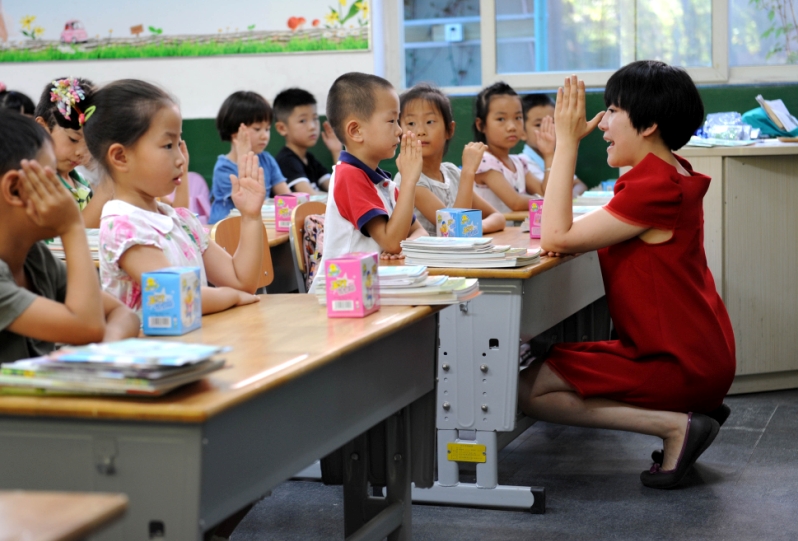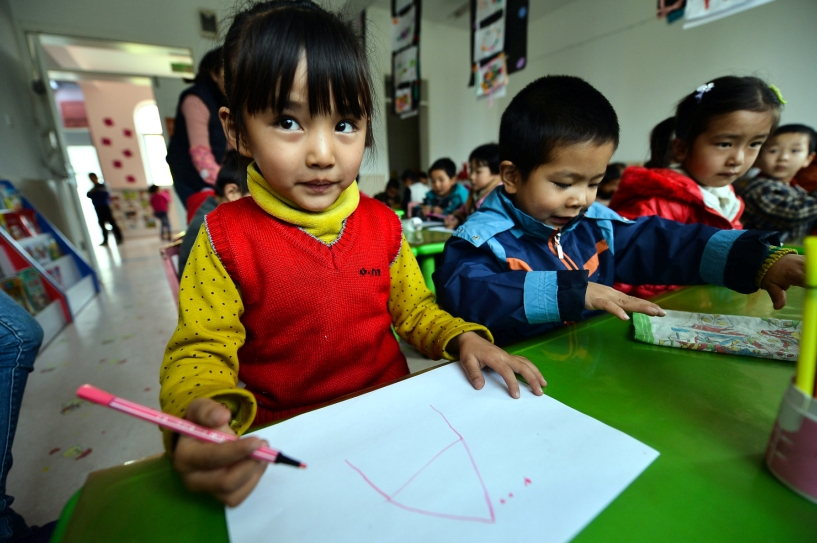| 
Pre-school children learn how to raise their hands to ask questions
Zhang Yuxin, only five years old, has a busy schedule. Every week, she spends more than 10 hours in different schools and training centers, learning math, English, piano, tennis and painting, since her parents believe these are the skills she must possess.
This gives one example of how intensely Chinese parents strive to give their children a competitive edge. This increasing awareness of getting ahead in the game has stimulated a booming pre-school education industry.
Among the many facets of the early childhood education industry in China, English training has become the most lucrative. In 2013, it was worth 24.5 billion yuan, making up 52 percent of the industry’s total value. Despite the booming demand for intensive training from a young age, the government has taken steps to reverse the trend.
The Ministry of Education reemphasized in its 2014 work plan that kindergarten students, who range in age from three to six, should not be subject to the same rigorous course material as older primary school students. Instead, the younger students should be given more time to play, work creatively and socialize with their peers. But regardless of this mandate, new children’s training schools have been sprouting up all over the country and foreign training centers have begun to break into the market, eager to fulfill the wishes of determined parents.

Art lessons are one of the many activities used to spark creativity in pre-schoolers
Demand grows
As competition in China’s society grows along with discretionary income, parents are increasingly willing to shell out thousands of yuan to give their children an edge.
“I dare say that there are few pre-school children in Beijing who have never attended any training classes,” Li Qiong, a Beijing-based children’s educator working at a center that offers classes for children aged three to 12, told ChinAfrica.
The center Li works for offers a course package designed for children who will enroll in primary school in September 2014. According to the center’s brochure, the five-month course can equip a child with knowledge of 1,000 Chinese characters, 400-500 English words, calculation skills for numbers under 20 as well as “comprehensive artistic abilities.”
Li, born in the late 1970s, never attended training courses as a child and began her schooling upon enrolling in primary school. But today, most children spend their first year in primary school repeating what they’ve already learned in training school.
“If we put aside parents’ anxiety, there is actually no need for such early study before primary school,” Li said. “The only necessary preparation is to build their capacity and habits of study.”
Wang Xinyi, the mother of a four-year-old son, believes pushing a child so hard before primary school is damaging in the long term.
“Most parents have no idea about what they really need to get their children prepared for primary school. They are just pushed forward by the great fear of losing in the game,” Wang said. Despite feeling this way, Wang was frequently warned by family members and other mothers about the stress her son would feel in primary school study if she doesn’t fully prepare him in advance.
With the average price for training courses soaring to about 200 yuan per hour, many parents still aren’t dissuaded. At the start of a session, parents often spend the evening lining up outside of the famous training schools to secure a seat. With this increased competition comes a lowering of the standard age schooling is started. Some schools offer courses for children as young as a few months old, and expecting mothers have begun trying to map out education plans during pregnancy.
But the emerging market is also unregulated, with few policies to help it develop. As the industry flourishes and new training centers have seemingly popped up overnight, many have had their credentials and qualifications questioned. Despite this uncertainty and the difficulty in measuring a center’s efficacy, many parents find the training schools irresistible.
“Even the adults have no idea what they really want, so it’s no wonder that they educate children blindly,” said Wang, who insisted her son would only begin training classes if he really wanted to himself, and instead began teaching him some basic Chinese characters and math at home.
Education vital
Wang noticed that among the most stressed parents are those from other cities, who settled in places like Beijing and Shanghai after graduating from top universities. Welleducated and successful, they understand the power of education in steering people’s lives toward success.
Since the gaokao, the national college entrance examination, was restored in 1977, education has been highly valued in China. In 1977, only 4.8 percent of 5.7 million students went to college; in 2013, the number of high school graduates applying for a college had grown to 9.15 million, while the admission rate had increased to 75 percent due to expanding enrollment policies in the past decades.
According to statistics from the National Bureau of Statistics, education spending accounted for almost half of China’s total household consumption in 2011. The parents of the new generation, mostly raising a single child under the one child policy, tend to invest more in their child’s education than previous generations did.
The new birth policy passed at the end of 2013 allows couples to have a second child if one parent is an only child. The change triggered a tense debate in China, but according to a survey by the Beijing Academy of Social Sciences, only 33 percent of Beijing citizens want a second child, with financial burden a main concern.
Meanwhile, among more than 20 million annual newborns in China, two out of three are in rural areas. But pre-school education in rural areas is still relatively poor in contrast to urban awareness about early childhood education.
To fill the gap between urban and rural education, the Central Government has invested 34 billion yuan from 2011 to 2013 to develop the country’s pre-school education, with great importance attached to supporting rural facilities and education for the children of migrant workers in urban cities. |